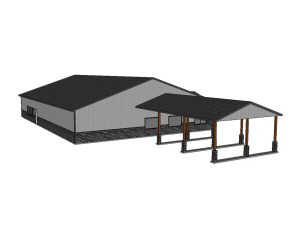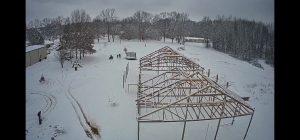As mentioned in a recent post (last Wednesday), recently while ‘net surfing, I stumbled across some interesting reading on a website for a hybrid steel frame – wood girts and purlins building.
The same website also had the benefits and/or disadvantages of all steel buildings. Again, I’ll present their information and then either agree or debunk it.
BENEFITS:
1. Wider/longer bay spacing, usually 20-25 feet. Set for door openings. True – as to wider bay spacing, but this is a disadvantage as all of the roof purlins and wall girts are also 20-25 feet long and are so heavy they must be handled by equipment.
2. Optional pre-framed windows and doors. True – same as for pole buildings.
 3. Low roof pitch, normally suggesting 1:12; some say it looks better. True – they are low sloped, however the majority of people feel this gives all steel buildings an “industrial” look.
3. Low roof pitch, normally suggesting 1:12; some say it looks better. True – they are low sloped, however the majority of people feel this gives all steel buildings an “industrial” look.
4. 26 gauge sheeting; thicker. True – 26 gauge is thicker than 29 gauge (which is generally used on pole buildings), the difference in thickness being about equal to a sheet of notebook paper.
5. Fewer frames to erect, effecting contractor’s time. True to fewer, false to effecting contractor’s time. All of those frames need to be installed on perfectly placed piers – get one wrong, there are problems.
6. Less concrete due to lower number of piers and although in many cases fixed connection (which will offset some of this savings). False – all steel building piers take an immense amount of concrete.
7. Insurance may be better as a non-combustion building. False – experience shows all steel buildings are more expensive to begin with. Insurance premiums are based upon replacement costs.
DISADVANTAGES:
1. Worst possible building for collapse in case of fire. Fire Department will not normally enter the building. True
2. Bolts are used instead of tek screws to apply the purlins and girts. So excess snow or ice levels, or excess wind up-lift causes the building to stretch, twist, and could collapse down as the bolts will not give. True – somewhat. Tek screws for frame assembly would not allow for minimal movement. All steel frames require tie-rods and cable braces to maintain frame rigidity.
3. By using 26 gauge sheeting, and the low roof pitch, they generally require the use of caulking which will dry out, shrink, crack and results in eventually roof leaks. True – somewhat. Low slope roofs do require the use of sidelap sealants, usually a butyl. Properly installed, the steel roofing should not leak.
4. By using 26 gauge or 24 gauge sheeting, with purlins on 48 inch O.C. (or more), the allowable uniform load is much less compared to purlins with 24” O.C. or less spacings. False – while the steel building purlins are spaced further apart, either an all steel or a pole building will be designed to whatever loads are specified.
5. A tek screw is used to fasten steel sheeting to steel purlin (vs. steel/wood), resulting in potential for up to 100%leaking as steel will not absorb water. False – properly installed neither screw should be prone to leaks. The statement infers somehow a screw into wood will not leak as the wood will absorb water? Water should never get to the purlins, in either case.
6. The plate steel type frame is very wobbly or flexing during the erecting stage and requires a great deal of bracing during construction. True – which is why the frame requires a great deal of cable bracing or tie rods.
7. To finish the inside with drywall or plywood, requires the application of strapping as the girts can be 48” to 84” O.C. You’re actually building another building inside to finish. True – all steel buildings are not user friendly when it comes to finishing the inside.
8. The fixed connection uses 10-15% more concrete in piers and is a less stable construction design, providing an overall limiting design safety factor. True – other than 10-15% more is probably an under estimation.
9. Most all steel building manufacturer/suppliers offer only a ONE YEAR warranty. Maybe – this would vary by manufacturer. In the case of an engineer certified Hansen Pole Building, the building comes with a limited lifetime structural warranty.
10. Typical application of insulation is a squeezed fiberglass option – offering a much reduced actual R- value and absolutely no reflective protection from radiant heat, unless covered with foil. True – all steel buildings, if insulated at all, utilize a product referred to as “metal building insulation”. This insulation is a fiberglass blanket, usually six feet wide, laminated to a vinyl facing. Applied over the steel roof purlins and beneath the roof steel, every time a purlin is crossed, the insulation is compressed to nothing – basically R-zero.
Whether you choose wood or steel framed, it’s good to have all the knowledge on each one of them to make a truly “informed” choice. Naturally I am sold on wood framed pole buildings. My Daddy was a framer and I grew up with a hammer in my hands, helping my Dad and 3 uncles with their framing crew. But they didn’t do pole buildings. I was sold on pole buildings when I studied them in the 1980’s as a cost effective, yet strong wood framed building which was simple in design and easy to construct. And after 32 years and counting, I’m still sold.










purlins are usually proprietary to metal building manufacturers. They of course are shaped like a Z in cross section and are made of light gage steel like 14, 16, 18 gauge (etc). They are typically roof members but can be wall girts as well. They vary in depths from 4 up to 10 or 12 inches deep and can be as thick as 10 gauge.
As used in post frame construction a purlin is a secondary horizontal framing member attached (generally at a right angle) to roof rafters or trusses. Laterally supports rafters and transfers load between exterior cladding and rafters/trusses. Serves as a structural member to which roof sheathing or roofing is attached. They resist gravity loads and uplift loads under wind loading conditions. As such they are a key structural element of the roof diaphragm assembly.
Most often purlins are two inch dimensional lumber.